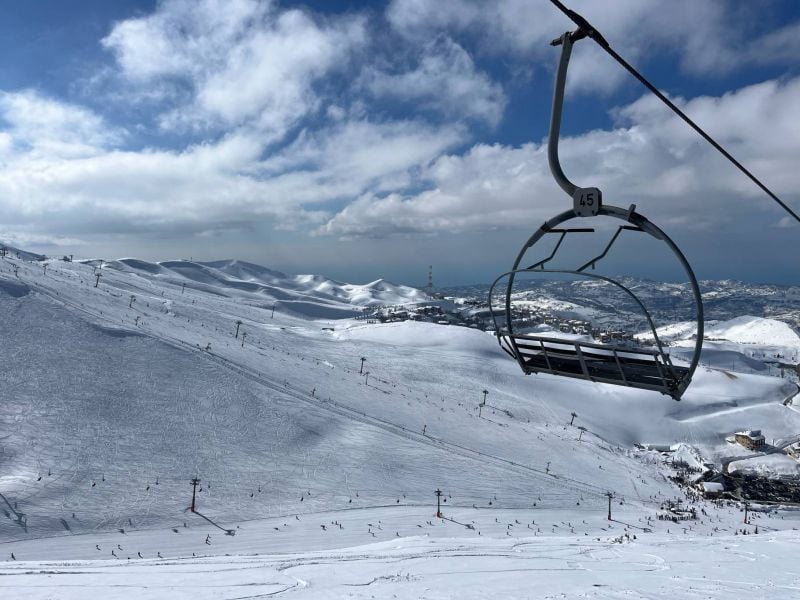
The Mzaar ski area (Mount Lebanon) in 2023. (Credit : O.B/L'OLJ)
As the 28th Conference of the Parties (COP28) in the United Arab Emirates concluded this week, the 198 participants, including Lebanon, are increasingly reflecting on the impact of climate change and its various effects on Lebanon’s environment, economy, and social structure. The increase in forest fires, the proliferation of pests, and the sea level rise, for instance, will threaten biodiversity, ecosystems, and fragile natural habitats. Among these disruptions, the expected effects on the tourism economy, particularly one of the most significant economic activities globally in the early 21st century and a traditionally important sector for Lebanon, are far from negligible.
Sea level rise impacts agriculture and increases risk of forest fires — these are some consequences in Lebanon, which, like many other countries, faces climate change impacts that can influence the tourism industry in various ways. Lebanese coastal areas could be affected by sea level rise, leading to negative results for tourist infrastructure and beaches. Periods of intense heat and prolonged drought can increase the risk of forest fires, not only threatening biodiversity but also affecting tourist destinations, especially those located near wooded areas.
That being said, with five ski resorts, Lebanon is the only Arab country in the Middle East to offer skiing activities in natural ski resorts, ranging in altitude from 1,700 to 2,850 meters, with three ski areas at altitudes between 1,000 and 2,000 meters – a significant comparative advantage in the Middle East, despite competition from some countries like Turkey (which has several natural ski resorts) or the United Arab Emirates, which has invested in artificial snow offerings. This competition did not prevent Lebanon from holding a prominent position in the "winter tourism market," with 202,069 ski days sold during the 2018/2019 winter season.
This advantage is even more valuable in prolonged crisis circumstances, as the ski season can generate significant foreign currency revenues for a struggling economy. Last March, caretaker Tourism Minister Walid Nassar, for example, declared that the approximately “700,000 tourists and Lebanese expatriates in the first two months of 2023 had generated nearly 1.5 billion dollars.”
Now, this comparative advantage is at great risk of eroding due to the combination of two factors. One, in the short term, is linked to the decrease in attendance due to the economic crisis and the regional geopolitical context. The other, in the longer term, is related to the vulnerability of Lebanese ski resorts to climate change. According to World Bank data, the average temperature recorded in January 2016 is similar to that of 1991, at seven degrees Celsius. However, during the interval, this monthly average has varied significantly, ranging from a peak of 10.1°C in 2010 to a low of 4.2°C in 1992. Despite these fluctuations, there is a clear trend towards a continuous increase in average temperatures.
In Lebanon, various climate change scenarios have been formulated using a downscaled General Circulation Model called PRECIS. These scenarios aim to project temperature and precipitation changes by the end of the 21st century. The results indicate that by 2040, temperatures are expected to increase by about 1°C along the coast and 2°C inland, with additional increases projected by 2090 ranging between 3.5°C and 5°C, respectively. Another notable impact concerns precipitation, which is expected to decrease by 10-20 percent in 2040 and potentially drop by 45 percent in 2090. This shift toward a drier and consistently warmer climate will prolong the duration of hot and arid conditions. Summer days are expected to have temperatures exceeding 35°C, and tropical nights temperatures exceeding 25°C. Additionally, drought periods in Lebanon are expected to lengthen by 9 to 18 days by 2090.
Furthermore, according to the same scenario, climate change is expected to lead to a reduction in snow cover from 40-70 percent, accompanied by a temperature increase of 2 to 4°C. This will result in a change in the health of the population and the environment. It will lead to an increase in the altitude of snowy areas (from 1,500m to 1,900m) and a decrease in the snow cover duration (from 110 days to 45 days).
These changes are naturally significant for the country’s attractiveness in terms of winter sports. The results of a questionnaire distributed to visitors of five ski resorts in Lebanon during the December 2017 to February 2018 ski season indicate that skiers were asked to rate factors of motivation and attraction on a scale from 1 to 7. The most attractive factor for skiers in Lebanon in 2018 is the pure mountain air, followed by snow cover – elements directly impacted by climate change.
In this context, various solutions can be considered by different stakeholders. Many countries have taken adaptive measures to address climate change, especially in the winter tourism sector. Global warming has led to milder winters in some regions of Canada, affecting the winter tourism industry. To attract tourists throughout the year, ski resorts, especially in British Columbia, are investing in snowmaking technologies, off-piste activities, and snow-related events. Ski resorts in Japan, particularly on Hokkaido Island, have also diversified their offerings by introducing activities such as snowshoeing, spring skiing and thermal tourism to compensate for these changes and maintain their tourist attractiveness.
Private investment in sustainable winter tourism has become a growing concern due to the challenges imposed by climate change. Businesses in the tourism sector, especially ski resorts and winter sports-related infrastructure, show increasing interest in integrating sustainable practices to reduce their environmental impact. Funds are allocated to environmental technologies, such as snow cannons using more efficient and energy-saving snow production methods.
These forms of private investment aim to make winter tourism more sustainable by minimizing its environmental impact while offering attractive experiences to visitors.
Mohamed KAYAL in an economist and academic coordinator at Sorbonne University Abu Dhabi.